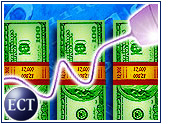
Holiday sales rose 24 percent over last year’s levels to US$13.7 billion, boosted by strong growth in online clothing sales and changes in the makeup of the Web shopping population, according to a new report.
That final tally from the eSpending report prepared by Goldman Sachs, Harris Interactive and Nielsen//NetRatings means sales far surpassed 2001 levels of $11 billion. And with travel spending included — it is usually excluded from such tallies — consumers spent $15.7 billion during the holiday period.
Lured by free shipping offers, increased confidence that items would be delivered on time and promotional discounts, the report suggests, shoppers also dedicated a greater proportion of their holiday budgets to the Web in 2002, spending 16 percent of their total outlay online.
The eSpending report covers all of November and December and found two spikes in shopping activity during those months, according to Harris Interactive director of e-commerce research Lori Iventosch-James.
“E-tailers pushing big discounts with free shipping in the beginning of November drove consumers to take advantage of the special savings early,” Iventosch-James said. “We also saw an increase in purchases right before Christmas this year, indicating that shoppers felt more comfortable waiting until the last minute.”
Dressing Up
The latest report confirms what many industry observers had expected — once again, e-commerce growth far outpaced nearly flat sales in the offline sector. Iventosch-James said two factors were at work: Experienced e-shoppers spent more money online, and the number of people buying on the Web continued to grow steadily.
Although CDs and books remained the most popular online purchases, with $3.1 billion spent on these items during the holiday season, consumers also seemed more willing to spend in categories that have lagged in the past. For instance, online sales of apparel grew 20 percent, according to the eSpending tally, becoming the second largest category, with $2.68 billion spent. Travel ranked third at $1.97 billion, followed by consumer electronics at $1.96 billion and toys and video games at $1.8 billion.
Profits, Too?
Still, the biggest test of the e-holiday shopping season is not yet over; in coming weeks, online bellwethers will report their fourth-quarter earnings. Amazon.com, for instance, will report on January 23rd. The e-tail giant will be watched closely to see if it can duplicate its first profit, booked in last year’s fourth quarter, and to measure the impact of its year-old experiment to offer free shipping on increasingly small orders.
The earnings of eBay, due January 16th, and Yahoo, which kicks off the earnings parade on January 15th, also should serve as barometers of whether the banner shopping season was as profitable as it was robust, or whether the high sales figures actually represented a losing proposition for online companies.
Lower Barriers
“Shipping costs are clearly a barrier to some shoppers, and it’s no coincidence that shopping activity has increased as they have been lowered,” Nielsen//NetRatings director and chief analyst Lisa Strand told the E-Commerce Times.
Strand also noted that much of this year’s early shopping was a result of heavy promotions by e-tailers worried that a shorter-than-normal holiday shopping season would crimp sales. “We’ll find out over time whether companies can still make money at the discount levels they had in place,” she said.
If all goes well, the holiday season may turn out to be the icing on the cake for 2002 e-commerce. Earlier this month, comScore Media Metrix pegged full-year sales at $74 billion, up nearly 40 percent from 2001. Forrester Research was even more bullish, putting the number closer to $80 billion for an increase of more than 50 percent over 2001 levels.
















































Social Media
See all Social Media